The solutions to Bridges in Mathematics Grade 3 Student Book Answer Key Unit 5 Module 1 can help students to clear their doubts quickly.
Bridges in Mathematics Grade 3 Student Book Answer Key Unit 5 Module 1
Bridges in Mathematics Grade 3 Student Book Unit 5 Module 1 Session 1 Answer Key
Comparing Fractions
Fill in the shapes to show the two fractions. Then compare them using < or>.
ex:
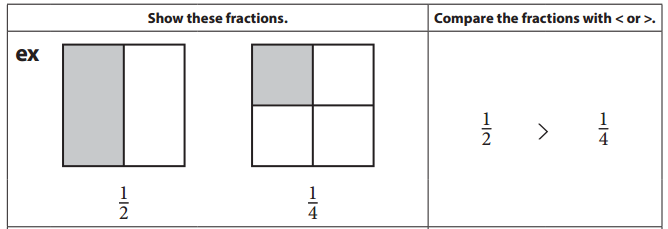
Question 1.
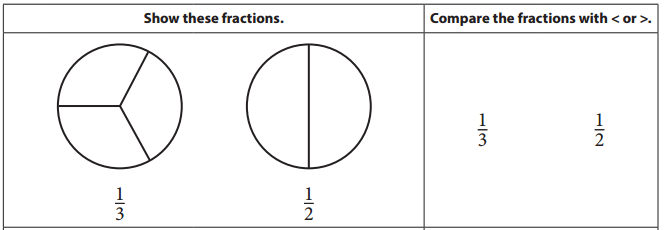
Answer:
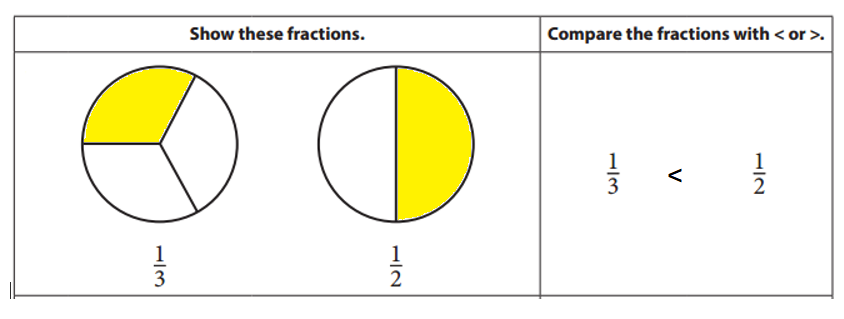
Explanation:
Shape to fill:
\(\frac{1}{3}\) = 0.33.
\(\frac{1}{2}\) = 0.5.
=> \(\frac{1}{3}\) is lesser than \(\frac{1}{2}\).
Question 2.

Answer:

Explanation:
Shape to fill:
\(\frac{2}{3}\) = 0.67.
\(\frac{2}{4}\) = 0.5.
=> \(\frac{2}{3}\) is greater than \(\frac{2}{4}\).
Question 3.
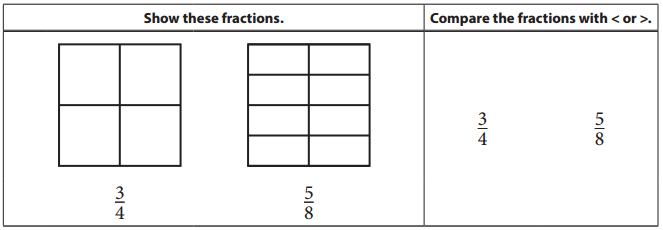
Answer:
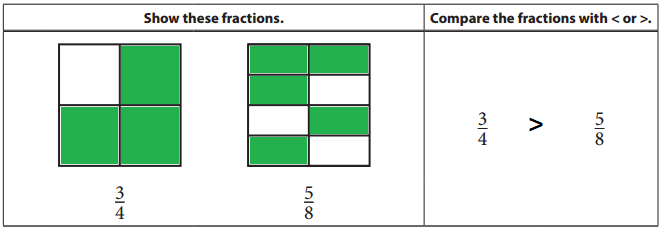
Explanation:
Shape to fill:
\(\frac{3}{4}\) = 0.75.
\(\frac{5}{8}\) = 0.625.
=> \(\frac{3}{4}\) is greater than \(\frac{5}{8}\).
Bridges in Mathematics Grade 3 Student Book Unit 5 Module 1 Session 2 Answer Key
Thinking About Fours
Question 1.
Write three mathematical observations about the Fours Chart. Include at least one observation about a row you can’t see.
a
b
c
Answer:
The three mathematical observations about the Fours Chart:
a. Addition (Finding the Sum; ‘+’)
b. Subtraction (Finding the difference; ‘-’)
c. Multiplication (Finding the product; ‘×’ )
Explanation:
The three mathematical observations about the Fours Chart:
The four basic arithmetic operations in Maths, for all real numbers, are:
a. Addition (Finding the Sum; ‘+’)
b. Subtraction (Finding the difference; ‘-’)
c. Multiplication (Finding the product; ‘×’ )
In a row, we cannot see total number of rows divided by total number of columns.
Question 2.
Draw a line from each question on the left to the matching expression on the right. Then write the answer to each.

Answer:
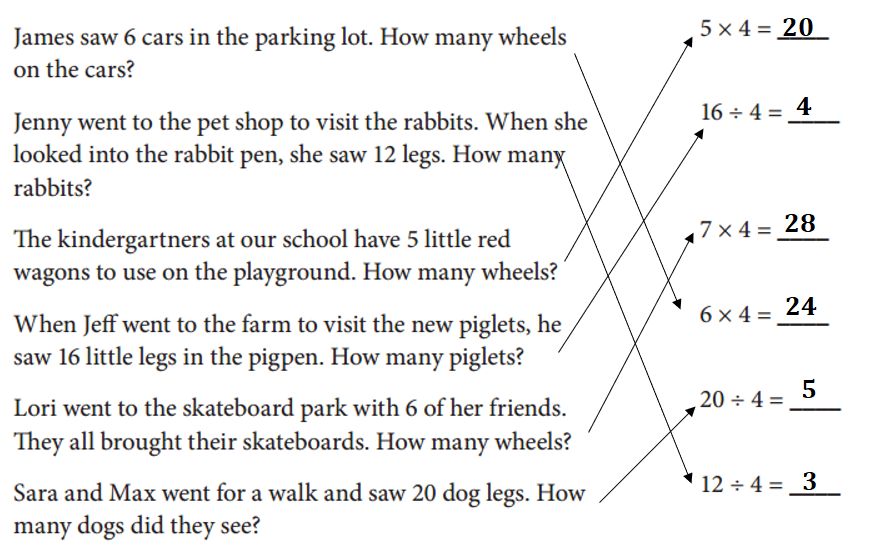
Explanation:
a. Number of wheels on the car = 6 × 4 = 24.
b. Number of rabbits = 12 ÷ 4 = 3.
c. Number of wheels = 5 × 4 = 20.
d. Number of piglets = 16 ÷ 4 = 4.
e. Number of wheels = 7 × 4 = 28.
f. Number of dogs they see = 20 ÷ 4 = 5.
Question 3.
Every square has 4 sides. Fill in the ratio table to show how many sides different numbers of squares have.

Answer:

Explanation:
Number of sides each square has = 4.
Number of squares Number of sides
1 1 × 4 = 4.
2 2 × 4 = 8.
3 3 × 4 = 12.
4 4 × 4 = 16.
5 5 × 4 = 20.
8 8 × 4 = 32.
10 10 × 4 = 40.
20 20 × 4 = 80.
50 50 × 4 = 200.
100 100 × 4 = 400.
16 = ?? × 4
=> 16 ÷ 4 = ??
=> 4 = ??.
40 = ?? × 4
=> 40 ÷ 4 = ??
=> 10 = ??0
400 = ?? × 4
=> 400 ÷ 4 = ??
=> 100 = ??
Question 4.
You will be circling and coloring in all the counting-by-4s numbers on the grid below.
a. Do you think 100 will be one of the numbers you circle and color in? Why or why not?
Answer:
Yes, 100 will be one of the numbers you circle and color in because it is a multiple of 4.
Explanation:
Number = 100
100 ÷ 4 = 25.
b. Now circle and color in all the counting-by-4s numbers on this grid.
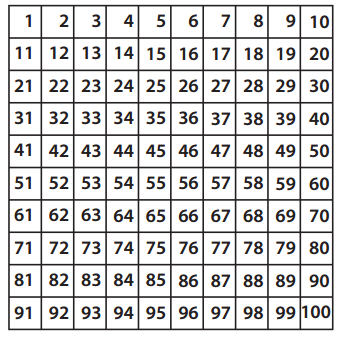
Answer:
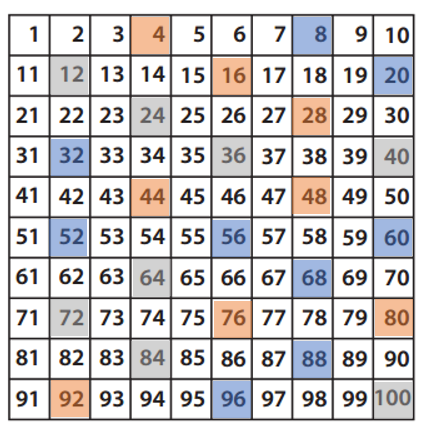
Explanation:
Multiples of 4:
4, 8, 12, 16, 20, 24, 28, 32, 36, 40, 44, 48, 52, 56, 60, 64, 68, 72, 76, 80, 84, 88, 92, 96, 100.
c. Is 100 one of those numbers?
Answer:
Yes, 100 is one of those numbers because 100 is multiple of 4.
Explanation:
Number = 100
100 ÷ 4 = 25.
Question 5.
Jake says that counting-by-4s numbers have to be even and they can never be odd. Do you agree with Jake? Why or why not?
Answer:
Yes, I agree with Jake because he says correct counting-by-4s numbers have to be even and they can never be odd.
Explanation:
Given number – 4.
4 is an even number.So, it has all even numbers as multiples or counting-by-4s numbers.
Writing Multiplication Equations
Write a count-by sequence and a multiplication equation to show the totals below.

a. Six elephants. How many ears?
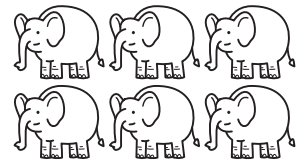
Count-by-Sequence: _____________
Multiplication Equation: ______________
Answer:
Total number of ears all elephants have = 12.
Count-by-Sequence: __2, 4, 6, 8, 10, 12.___________
Multiplication Equation: _____2 × 6 = 12._________
Explanation:
Number of ears each elephant has = 2.
Number of elephants = 6.
Total number of ears all elephants have = Number of ears each elephant has × Number of elephants
= 2 × 6
= 12.
b. Eight dimes. How many cents?
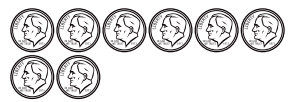
Count-by-Sequence: _____________
Multiplication Equation: ______________
Answer:
Total number of cents = 80.
Count-by-Sequence: 10, 20, 30, 40, 50, 60, 70, 80.
Multiplication Equation: 8 × 10 = 80.
Explanation:
Number of dimes = 8.
Conversion:
1 Dime = 10 cents.
Total number of cents = Number of dimes × 10
= 8 × 10
= 80.
c. Seven sea stars. How many arms?
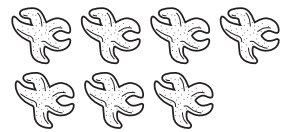
Count-by-Sequence: _____________
Multiplication Equation: ______________
Answer:
Total number of arms all stars have = 35.
Count-by-Sequence: 5, 10, 15, 20, 25, 30, 35.
Multiplication Equation: 7 × 5 = 35.
Explanation:
Number of sea stars = 7.
Number of arms each star has = 5.
Total number of arms all stars have = Number of sea stars × Number of arms each star has
= 7 × 5
= 35.
d. CHALLENGE Five egg cartons. How many eggs?
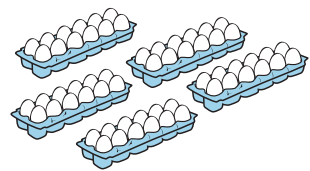
Count-by-Sequence: _____________
Multiplication Equation: ______________
Answer:
Total number of eggs in all cartons = 60.
Count-by-Sequence: 12, 24, 36, 48, 60.
Multiplication Equation: 5 × 12 = 60.
Explanation:
Number of carton eggs = 5.
Number of eggs in each egg carton = 12.
Total number of eggs in all cartons = Number of carton eggs × Number of eggs in each egg carton
= 5 × 12
= 60.
Bridges in Mathematics Grade 3 Student Book Unit 5 Module 1 Session 3 Answer Key
Multiplication Arrays
Question 1.
Complete the multiplication facts.

Answer:

Explanation:
Given Equations:
3 × 4 12. 3 × 3 = 9. 4 × 6 = 24. 4 × 4 = 16. 6 × 3 = 18. 3 × 8 = 24. 4 × 9 = 36.
6 × 7 = 42. 3 × 9 = 27. 5 × 2 = 10. 3 × 5 = 15. 5 × 4 = 20. 4 × 7 = 28. 8 × 0 = 0.
Question 2.
Use the array to show how you could solve each fact.
ex: 3 × 7 = 21

a. 4 × 8 = ______________
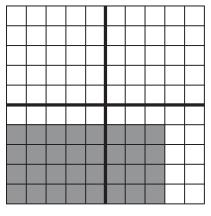
Answer:
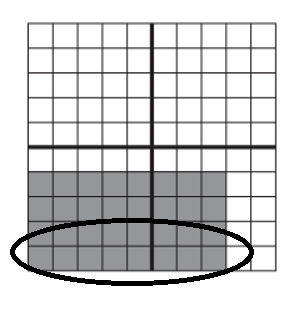
Equations:
2 × 8 = 16.
16 + 16 = 32.
Explanation:
Given shaded dimensions = 8 & 4.
4 × 8 = 32.
Equations:
2 × 8 = 16.
16 + 16 = 32.
b. 6 × 9 = _______________

Answer:
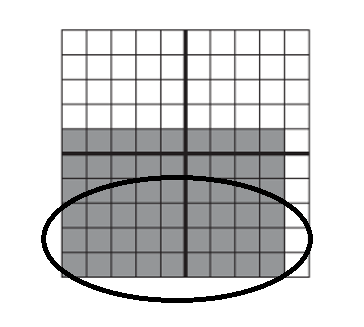
Equations:
4 × 9 = 36.
36 + 18 = 54.
Explanation:
Given shaded dimensions = 6 & 9.
6 × 9 = 54.
Equations:
4 × 9 = 36.
36 + 18 = 54.
c. 7 × 4 = _______________
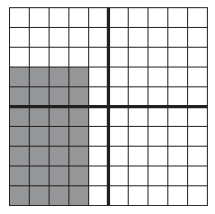
Answer:
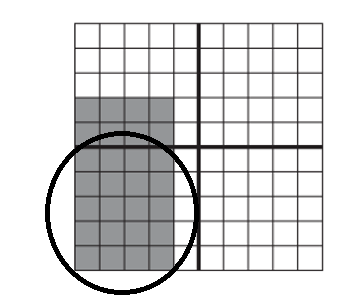
Equations:
5 × 4 = 20.
20 + 8 = 28.
Explanation:
Given shaded dimensions = 7 & 4.
7 × 4 = 28.
Equations:
5 × 4 = 20.
20 + 8 = 28.
Bridges in Mathematics Grade 3 Student Book Unit 5 Module 1 Session 4 Answer Key
Flowers, Shells & Cards
Question 1.
Lisa, Imani, and Carla were picking flowers for their aunt. If they each picked 8 flowers, how many flowers did they pick in all? Show all your work.

Answer:
Total number of flowers they picked in all = 24.
Explanation:
Number of flowers they each picked = 8.
Number of people = 3.
Total number of flowers they picked in all = Number of flowers they each picked × Number of people
= 8 × 3
= 24.
Question 2.
Frank collected 18 beautiful shells for his 3 cousins. If he gave each cousin the same number of shells, how many shells did each cousin get? Show all your work.
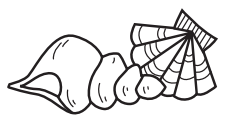
Answer:
Number of beautiful shells each cousin gets = 6.
Explanation:
Number of beautiful shells Frank collected = 18.
Number of cousins = 3.
Number of beautiful shells each cousin gets = Number of beautiful shells Frank collected ÷ Number of cousins
= 18 ÷ 3
= 6.
Question 3.
CHALLENGE Four friends were making cards to sell at the holiday sale. Each friend made 9 cards. They put all their cards together and then bundled them in groups of 6 cards to sell. How many bundles of 6 cards did they have to sell? Show all your work.
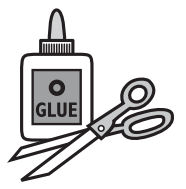
Answer:
Number of bundles of 6 cards they have to sell = 6.
Explanation:
Number of friends making cards to sell at the holiday sale = 4.
Number of cards each friend made = 9.
Number of cards bundled them in groups to sell = 6.
Number of bundles of 6 cards they have to sell = (Number of friends making cards to sell at the holiday sale × Number of cards each friend made) ÷ Number of cards bundled them in groups to sell
= (4 × 9) ÷ 6
= 36 ÷ 6
= 6.
Bridges in Mathematics Grade 3 Student Book Unit 5 Module 1 Session 5 Answer Key
Cats & Kittens
Pick the equation you could use to solve each problem. Then solve the problem.
Question 1.
Ray’s cat had 6 kittens. His neighbor adopted 2 of them. How many kittens does Ray have left?
![]() 6 ÷ 2 = ?
6 ÷ 2 = ?
![]() 6 + 2 = ?
6 + 2 = ?
![]() 6 – 2 = ?
6 – 2 = ?
![]() 6 × 2 = ?
6 × 2 = ?
Ray had ______________ kittens left.
Answer:
Number of kittens Ray have left = 4.
![]() 6 – 2 = ?
6 – 2 = ?
Ray had 4 kittens left.
Explanation:
Number of kittens Ray’s cat had = 6.
Number of kittens Ray’s neighbor adopted = 2.
Number of kittens Ray have left = Number of kittens Ray’s cat had – Number of kittens Ray’s neighbor adopted
= 6 – 2
= 4.
Question 2.
Marsha’s cat had 6 kittens. She gave all of them away by giving 2 kittens each to some of her neighbors. How many neighbors got 2 kittens?
![]() 6 ÷ 2 = ?
6 ÷ 2 = ?
![]() 6 + 2 = ?
6 + 2 = ?
![]() 6 – 2 = ?
6 – 2 = ?
![]() 6 × 2 = ?
6 × 2 = ?
______________ neighbors got 2 kittens each.
Answer:
Number of neighbors got 2 kittens = 3.
![]() 6 ÷ 2 = ?
6 ÷ 2 = ?
3 neighbors got 2 kittens each.
Explanation:
Number of kittens Marsha’s cat had = 6.
Number of kittens she gave to her neighbours each = 2.
Number of neighbors got 2 kittens = Number of kittens Marsha’s cat had ÷ Number of kittens she gave to her neighbours each
= 6 ÷ 2
= 3.
Question 3.
One of Larry’s cats had 6 kittens. Another one of his cats had only 2 kittens. How many kittens were there in all?
![]() 6 ÷ 2 = ?
6 ÷ 2 = ?
![]() 6 + 2 = ?
6 + 2 = ?
![]() 6 – 2 = ?
6 – 2 = ?
![]() 6 × 2 = ?
6 × 2 = ?
There were _____________ kittens in all.
Answer:
Number of kittens were there in all = 8.
![]() 6 + 2 = ?
6 + 2 = ?
There were 8 kittens in all.
Explanation:
Number of kittens one of Larry’s cats had = 6.
Number of kittens another one of his cats had = 2.
Number of kittens were there in all = Number of kittens one of Larry’s cats had + Number of kittens another one of his cats had
= 6 + 2
= 8.
Question 4.
Write a story problem to match this equation. 24 ÷ 3 = _____________

Solve the story problem. Write your answer here: ________________
Answer:
Question: Tim had 24 kittens. He gave all of them away by giving 3 kittens each to some of her neighbors. How many neighbors got 3 kittens?
Solution: Number of neighbors got 3 kittens = 8.
Explanation:
Number of kittens Marsha’s cat had = 24.
Number of kittens she gave to her neighbours each = 3.
Number of neighbors got 3 kittens = Number of kittens Marsha’s cat had ÷ Number of kittens she gave to her neighbours each
= 24 ÷ 3
= 8.
Bridges in Mathematics Grade 3 Student Book Unit 5 Module 1 Session 6 Answer Key
Solving Game Store Problems
I am solving _____________’s problem.
I estimate a reasonable answer will be: (circle one)

The problem I am trying to figure out is:
Here’s my equation:
This is my work:

Answer:
I am solving 10 ’s problem.
Explanation:
Given numbers:
< 10, 20, 30, 40, 50, 60, 70, 80, 90, 100 >.
=> Numbers difference:
10 – 0 =10.
Work Place Instructions 5A Solving Game Store Problems
This is an activity for 1 person. The student needs:
- 1 5A Solving Game Store Problems sheet
- copies of story problems written by classmates
- access to colored tiles and/or base ten pieces
1. The student chooses a story problem that seems interesting, and estimates what a reasonable answer might be.
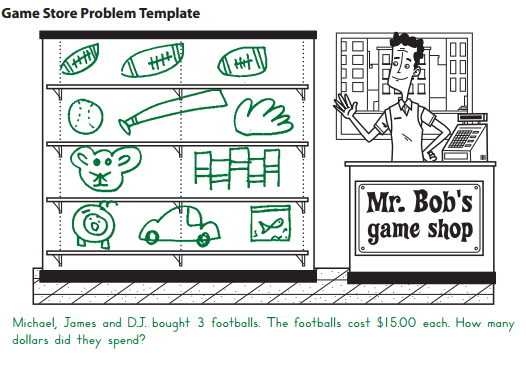
2. The student records the name of the person who wrote the problem, and restates what the problem is asking. Then the student writes an equation to match the problem, with a box to stand for the answer.
3. The student uses sketches, tiles, base ten pieces, or any other tools needed to to solve the problem.
4. Then the student shows his or her thinking with numbers, labeled sketches, or words.
5. Last, the student edits his or her work to be sure it meets the class guidelines.
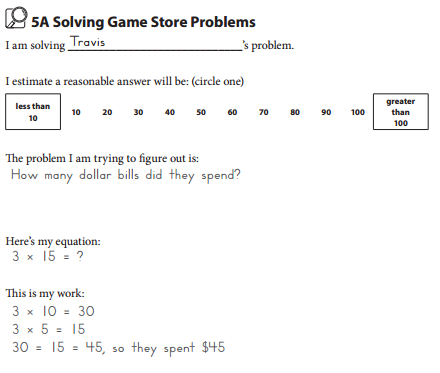
Undersea Adventures
Question 1.
Chloe the clownfish is 4 inches long. There is a sea snake in the area that is 8 times as long as Chloe. How long is the sea snake? Show your work.
Answer:
Number of inches sea snake = 32.
Explanation:
Number of inches Chloe the clownfish = 4.
Number of times the sea snake in the area = 8.
Number of inches sea snake = Number of inches Chloe the clownfish × Number of times the sea snake in the area
= 4 × 8
= 32.
Question 2.
Some brain coral nearby is 11 times as wide as Chloe is long. How wide is the brain coral?
Answer:
Number of inches the brain coral = 44.
Explanation:
Number of inches Chloe the clownfish = 4.
Number of times Some brain coral nearby = 11.
Number of inches the brain coral = Number of inches Chloe the clownfish × Number of times Some brain coral nearby
= 4 × 11
= 44.
Question 3.
Chloe swam behind a sea anemone that was 3 times as wide as Chloe is long. Then Chloe saw a basket sea star that was twice as wide as the anemone. How wide is the basket sea star?
Answer:
Number of inches wide is the basket sea star = 24.
Explanation:
Number of times Chloe swam behind a sea anemone = 3.
Number of inches Chloe the clownfish = 4.
Number of inches a sea anemone = Number of times Chloe swam behind a sea anemone × Number of inches Chloe the clownfish
= 3 × 4
= 12.
Chloe saw a basket sea star that was twice as wide as the anemone.
Number of inches wide is the basket sea star = 2 × Number of inches a sea anemone
= 2 × 12
= 24.
Question 4.
Use a dollar sign and decimal point to write the value of each group of coins.
ex:

a.

Answer:
Value of 3 pennies = $0.03.
Explanation:
Number of pennies = 3.
Conversion:
1 dollars = 100 pennies.
?? dollar = 3 pennies
=> 1 × 3 = 100 × ??
=> 3 ÷ 100 = ??
=> 0.03 = ??
b.

Answer:
Value of 3 dimes = $0.3.
Explanation:
Number of dimes = 3.
Conversion:
1 dollar = 10 dimes.
?? = 3 dimes
=> 1 × 3 = 10 × ??
=> 3 ÷ 10 = ??
=> 0.3 = ??
c.

Answer:
Value of 2 nickles = $0.2.
Explanation:
Number of nickles = 2.
Conversion:
1 dollar = 10 nickles.
?? = 2 nickles.
=> 1 × 2 = 10 × ??
=> 2 ÷ 10 = ??
=> 0.2 = ??.
d.
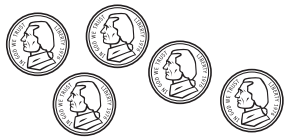
Answer:
Value of 5 nickles = $0.5.
Explanation:
Number of nickles = 5.
Conversion:
1 dollar = 10 nickles.
?? = 5 nickles.
=> 1 × 5 = 10 × ??
=> 5 ÷ 10 = ??
=> 0.5 = ??.
e.
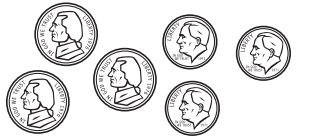
Answer:
Value of given coins = $0.33.
Explanation:
Number of nickles = 3.
Number of pennies = 3.
Conversion:
1 dollar = 10 nickles.
?? = 3 nickles.
=> 1 × 3 = 10 × ??
=> 3 ÷ 10 = ??
=> 0.3 = ??
Conversion:
1 dollar = 100 pennies.
?? = 3 pennies.
=> 1 × 3 = 100 × ??
=> 3 ÷ 100 = ??
=> 0.03 = ??.
Total = $0.3 + $0.03 = $0.33.